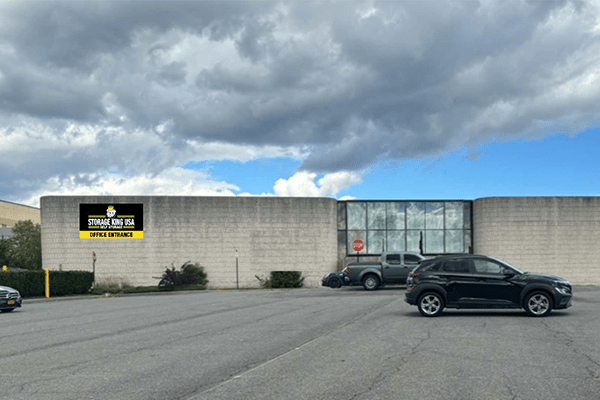|
RCBJ-Audible (Listen For Free)
|
Developers Look To Site Storage Facilities In Locations That Offer Least Path of Resistance In The Planning/Zoning Process
By Andy Milone
Remember when attics and basements had enough room to store baby clothes, yearbooks, and other ephemera that people just couldn’t part with?
Somewhere along the way, people were convinced that they needed self-storage units, and developers responded to the demand. Only recently, the long-vacant Macy’s site in Nanuet turned more than 106,000 square feet into Storage King USA. West Rock Tennis Club in the Town of Clarkstown has been repurposed into Prime Storage. An application to fill a long-vacant lot on West Ramapo Road in Haverstraw with a 108,600 square foot mini-storage is next on the list.
The eruption of self-storage facilities in Rockland County, especially in the Route 59, 9W and 303 corridors, includes new construction and the conversion of existing buildings. While the proliferation of storage units slows elsewhere, the appetite here remains strong.
In January 2022, Extra Space Storage, a Class A state-of-the-art self-storage facility, developed in partnership with the Rockland County-based Kirchner and Yassky families, and the Poughkeepsie-based real estate investment firm Kirchhoff, opened a facility that is visible from the New York State Thruway. The property previously housed engineering and manufacturing firms. The developer converted the building from a one-story, 52,000 square-foot building into a two-story structure comprising more than 100,000 square feet.
TAC Pearl River LLC built a storage facility between Railroad Avenue and Route 304 in Pearl River, at a largely vacant wooded site bordered by commercial and industrial businesses just north of the hamlet’s downtown at 112 West Crooked Hill Road.
Another project in Congers was completed by Treetop Development. A Teaneck, New Jersey based real estate investment firm run by Adam Mermelstein and Azi Mandel, built a 90,000 square-foot self-storage facility on 6.4 acres of vacant land at 287 North Route 303.
And the developers of Gateway Commons of Nanuet, formerly known as Thruway Plaza Shopping Center, have swapped plans for a Holiday Inn Express for a 115,000 square-foot self-storage facility, pending approvals.
Self-storage facilities are among the most fervent trends in commercial development, along with warehouses and senior housing projects in Rockland County. In some parts of the country, the once-hot proliferation of storage facilities is cooling, according to industry experts.
In 2024, the interest in self-storage projects has significantly dropped off nationwide because of interest rates, said Tim Ryan, Senior Vice President with Newmark’s self-storage team in the Northeast/New York Metro areas. “The industry peaked in 2021 and 2022.”
But the slowdown might be temporary, and geographic.
“Some of the bellwethers of the industry are kind of in a down cycle right now,” said Ryan. “It’s not expected to last long term; I’m seeing people waiting,”
For those who are determined, the ease of building in a location is a strategic part of the equation.
The New York Self Storage Association in a recent newsletter wrote competition is recognized by stakeholders as “very disruptive” during a time when developers have a lot of data available to them. In turn, they can pick spots to avoid competition and create the greatest return.”
In other words, they look for the path of least resistance.
Developers try to avoid markets with difficult land-use processes, lack of tax incentives, or those with building moratoriums in place.
Development of storage facilities continues unabated in Rockland County. SpareFoot and SelfStorage.com have 15 facilities listed, but RCBJ counts 20 open, with more moving through local land use boards. Comparatively, Westchester County has double that amount.
Susan Meyer, a senior public information specialist at Rockland County Planning Department, noted in an email that its land use review database shows some ten projects having been proposed since 2013. However, that estimate is low because the county does not review every application.
The planning spokesperson declined comment on any trends, noting the department offers “official comments” on applications during the review process.
Officials have reached a crossroads though. Meyer said this year the county plans to review and update its comprehensive plan, a key to guiding development in the future. “That will give officials and their communities the opportunity to evaluate their vision,” she said.
That update may be the time to reflect on controversial projects like the 120,000-square-foot storage facility proposed for a 17-acre parcel at 636 North Greenbush Road in Orangetown.
Dinosaur tracks and a successful zoning petition to amend a commercial boundary demarcation to accommodate plans are among the issues that have arisen as neighbors fight the plan.
“It’s the wrong project for the wrong place,” said Vanessa Lapins of Blauvelt with CUPON (Citizens United to Protect Our Neighborhood.) “Look for an already developed area that is underused and not in pristine woodland,” Lapins added.
Still, Lapins said storage facilities are not as bad as warehouses, which are also proliferating in the county.
“Self-storage is certainly better than warehouses because you don’t have the truck traffic coming in and out. You have the occasional person or small truck coming to deposit some things.”
“Long Island and Upstate have all experienced significant levels of self-storage development,” according to SelfStorage.com “That is due in part to the lull in new development that occurred after the last recession.”
In 2021 and 2022, Ryan said developers were more aggressively pursuing projects during and after the COVID-19 pandemic when people were moving from their dwellings and uprooting from offices to work at home.
And despite the lull in some parts of the country, Ryan added, “People are always going to have stuff and apartments are getting smaller and smaller and there’s just always going to be a need.”
Nationally, the demand for self-storage cooled as a glut of new supply hit the market, particularly in cities like Phoenix and Atlanta, Tyson Huebner, director of research at Yardi Matrix, a division of the property-management software firm Yardi, said in a recent New York Times report.
“It was really attractive in the moment, but as soon as you go through planning, building, by the time you deliver, you’re kind of in a different market,” Huebner said.
The Sun Belt markets are where much of the self-storage spaces have been built over the past couple of years, the report notes.
Sometimes, those in charge of approved sites see their permits lapse when they “can’t make the deals pencil” if not seeing potential return, said Ryan.
Often times, residents will aim to fight warehouse and storage facility developments but proposals tend to be on sites that are already zoned for the use.
“Municipalities are particular about who or what is coming into their neighborhood, said Nicholas Malagisi, national director of Self Storage at SVN, and fellow senior advisor Brian Dano, in a written piece. “In other words, NIMBY (not in my backyard) is alive and well in certain municipalities where self-storage is still thought of as a non-essential use.”
Developers tend to seek out sites of at least one acre with major frontage and visibility from the roadway, as well as good access to highways, room for turning radius and, of course, favorable zoning.
Ryan added, “They’re not usually the prettiest looking facilities and people will wonder why you aren’t building housing in this time where a lot of areas are underserved.”
Once built, Ryan says storage facilities are “recession resilient” investments. They’ve become “universally accepted” over the past decade or so, and more recently are at the center of a lot of adaptive reuse projects.
The “main lenders” have a “significant amount of self-storage on their balance sheet” and now it’s become “one of the core asset classes as opposed to an alternative asset class.” The overall perception is that self-storage is a rewarding, high return industry. This isn’t like a retail shopping center where you have five tenants. These are facilities where you could have three story building that has hundreds of units, so getting those to fill up brings a secure return to an investor.”











